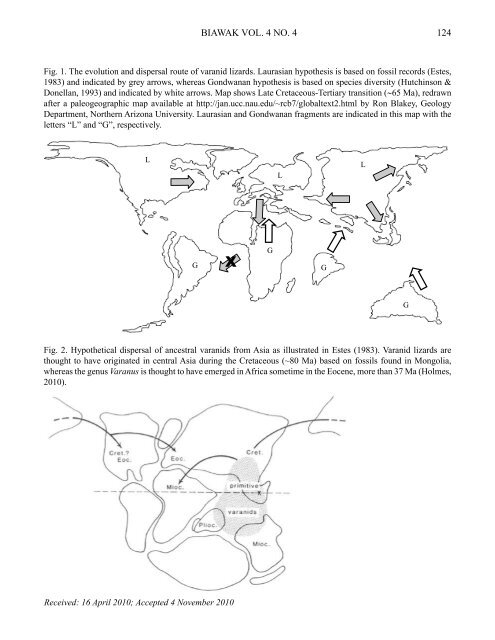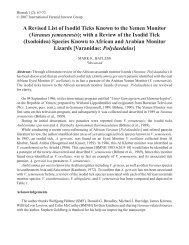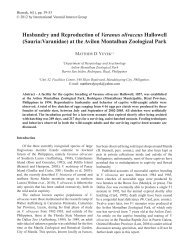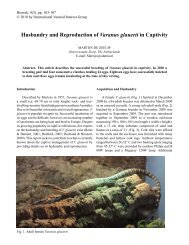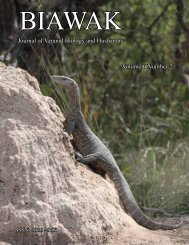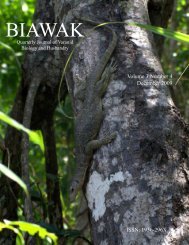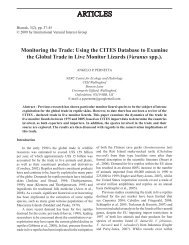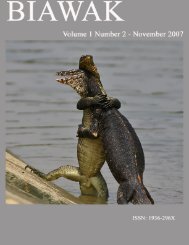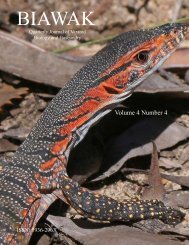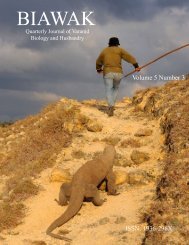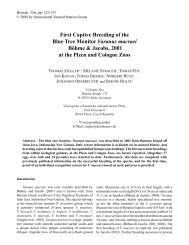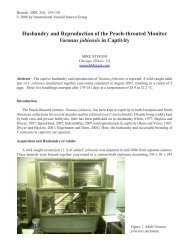BIAWAK - International Varanid Interest Group
BIAWAK - International Varanid Interest Group
BIAWAK - International Varanid Interest Group
- No tags were found...
Create successful ePaper yourself
Turn your PDF publications into a flip-book with our unique Google optimized e-Paper software.
<strong>BIAWAK</strong> VOL. 4 NO. 4<br />
124<br />
Fig. 1. The evolution and dispersal route of varanid lizards. Laurasian hypothesis is based on fossil records (Estes,<br />
1983) and indicated by grey arrows, whereas Gondwanan hypothesis is based on species diversity (Hutchinson &<br />
Donellan,<br />
Figure 1. The1993) evolution<br />
and<br />
andindicated dispersal route<br />
by<br />
of<br />
white<br />
varanid<br />
arrows.<br />
lizards. Laurasian<br />
Map shows<br />
hypothesis<br />
Late<br />
isCretaceous-Tertiary based on fossil records (Estes,<br />
transition<br />
1983) and<br />
(∼65<br />
indicated<br />
Ma),<br />
inredrawn<br />
grey<br />
after arrows, a whereas paleogeographic Gondwanan hypothesis map available is based on at species http://jan.ucc.nau.edu/~rcb7/globaltext2.html diversity (Hutchinson & Donellan, 1993) and indicated in by white Ron arrows. Blakey, Map shows Geology<br />
Department, Late Cretaceous-Tertiary Northern transition Arizona (∼65University. Ma), redrawn after Laurasian a paleogeographic and Gondwanan map availablefragments at http://jan.ucc.nau.edu/~rcb7/globaltext2.html are indicated in this map with by the<br />
Ron Blakey, at Geology Department, Northern Arizona University. Laurasian and Gondwanan fragments are indicated in this map with the letter<br />
letters “L” and “G”, respectively.<br />
„L“ and „G“, respectively.<br />
L<br />
L<br />
L<br />
G<br />
G<br />
X<br />
G<br />
G<br />
G<br />
G<br />
G<br />
G<br />
Fig. 2. Hypothetical dispersal of ancestral varanids from Asia as illustrated in Estes (1983). <strong>Varanid</strong> lizards are<br />
thought to have originated in central Asia during the Cretaceous (~80 Ma) based on fossils found in Mongolia,<br />
whereas the genus Varanus is thought to have emerged in Africa sometime in the Eocene, more than 37 Ma (Holmes,<br />
2010).<br />
Received: 16 April 2010; Accepted 4 November 2010


